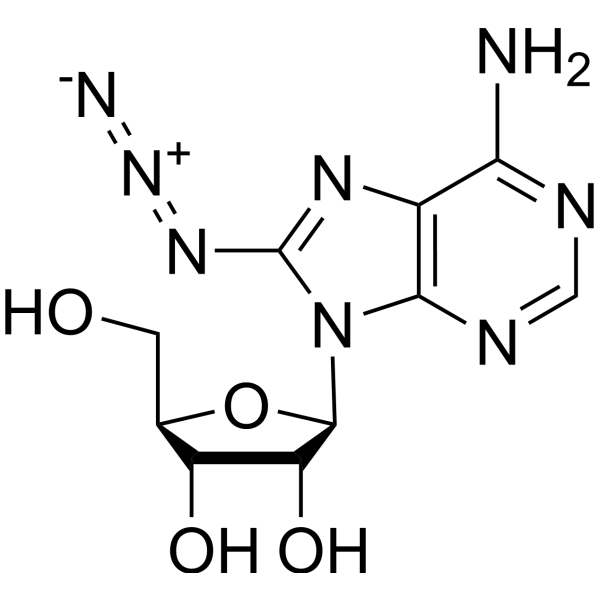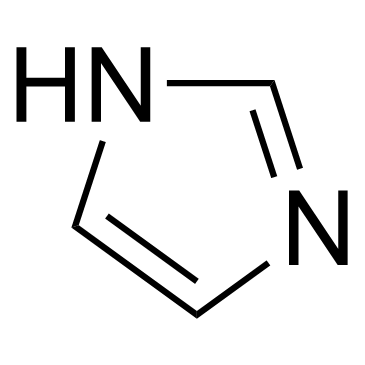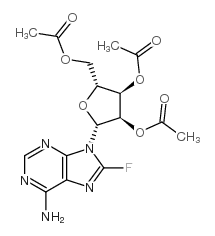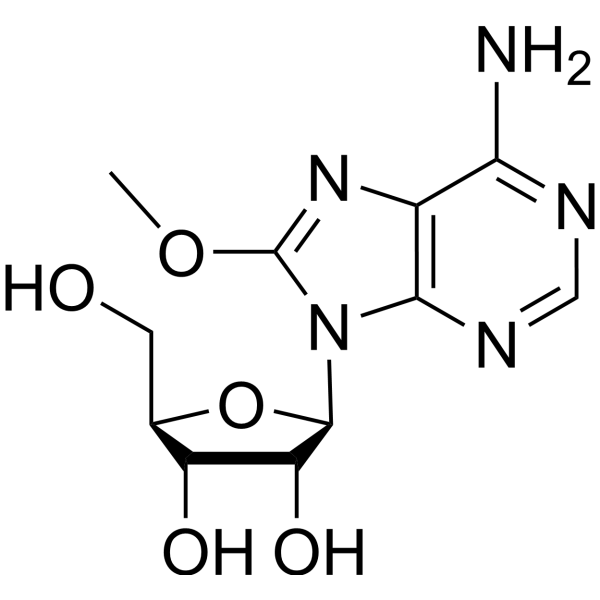8-Aminoadenosine

8-Aminoadenosine structure
|
Common Name | 8-Aminoadenosine | ||
|---|---|---|---|---|
| CAS Number | 3868-33-5 | Molecular Weight | 282.26 | |
| Density | 2.25g/cm3 | Boiling Point | 747.1ºC at 760mmHg | |
| Molecular Formula | C10H14N6O4 | Melting Point | 180-185ºC dec. | |
| MSDS | Chinese USA | Flash Point | 405.6ºC | |
| Symbol |

GHS06 |
Signal Word | Danger | |
Use of 8-Aminoadenosine8-Aminoadenosine (8-NH2-Ado), a RNA-directed nucleoside analogue, reduces cellular ATP levels and inhibits mRNA synthesis. 8-Aminoadenosine blocks Akt/mTOR signaling and induces autophagy and apoptosis in a p53-independent manner. 8-Aminoadenosine has antitumor activity[1][2][3]. |
| Name | 8-aminoadenosine |
|---|---|
| Synonym | More Synonyms |
| Description | 8-Aminoadenosine (8-NH2-Ado), a RNA-directed nucleoside analogue, reduces cellular ATP levels and inhibits mRNA synthesis. 8-Aminoadenosine blocks Akt/mTOR signaling and induces autophagy and apoptosis in a p53-independent manner. 8-Aminoadenosine has antitumor activity[1][2][3]. |
|---|---|
| Related Catalog | |
| Target |
Akt mTOR |
| In Vitro | 8-Aminoadenosine (8-NH2-Ado; 0.1-10 μM; for 48 h) has IC50s of 1.5 μM and 8.88 μM in MM.1S and U266 cells, respectively[1]. 8-Aminoadenosine (10 μM; for 24 h) induces significant apoptotic death of MCF-7 cells in p53-independent pathway. 8-Aminoadenosine causes PARP cleavage in MCF-7 cells[2]. 8-Aminoadenosine (3 μM; 0.5-4 h) induces autophagy in the MM.1S cell line[1]. 8-Aminoadenosine (3 μM; 2-16 h) causes a greater drop in ATP levels in the MM.1S cells[1]. 8-Aminoadenosine (3 μM; 5 h) causes a 50% reduction in glucose consumption in MM.1S cells[1]. 8-Aminoadenosine (3 μM; 5 h) indicates a time-dependent decrease in GLUT1 expression at 5 h, whereas at 24 h there was a down-regulation of both transporters (GLUT1 and GLUT4) in MM.1S cells[1]. 8-Aminoadenosine inhibits cell proliferation, activated cell death, and does not activate transcription of the p53 target gene p21 or increase protein levels of either p53 or p21[1]. The toxic effects of 8-Aminoadenosine require adenosine kinase activity to convert 8-Aminoadenosine to 8-NH2-ATP in adenosine kinase-deficient cells[1]. Cell Viability Assay[1] Cell Line: MM.1S and U266 cells Concentration: 0.1, 0.3, 1, 3, 10 μM Incubation Time: For 48 hours Result: Had IC50s of 1.5 μM and 8.88 μM in MM.1S and U266 cells, respectively. Apoptosis Analysis[2] Cell Line: MCF-7 cells Concentration: 10 μM Incubation Time: For 24 hours Result: Induced significant apoptotic death. Apoptosis was not inhibited by knockdown of functional p53. Apoptosis Analysis[1] Cell Line: MM.1S cell line Concentration: 3 μM Incubation Time: 0.5, 1, 1.5, 2, 2.5, 3, 3.5, 4 hours Result: Induced the formation of LC3-II protein. Caused the appearance of a population with a high AVO content with 1 μM for 24 hours. |
| References |
| Density | 2.25g/cm3 |
|---|---|
| Boiling Point | 747.1ºC at 760mmHg |
| Melting Point | 180-185ºC dec. |
| Molecular Formula | C10H14N6O4 |
| Molecular Weight | 282.26 |
| Flash Point | 405.6ºC |
| Exact Mass | 282.10800 |
| PSA | 165.56000 |
| Appearance of Characters | white to beige |
| Storage condition | -20?C Freezer |
| Water Solubility | H2O: soluble2mg/mL, clear (warmed) |
|
Property editing of peptide nucleic acids (PNA): gem-dimethyl, cyanuryl and 8-aminoadenine PNAs.
Nucleic Acids Symp. Ser. (51) , 17-8, (2007) We herein describe the introduction of gem-dimethyl substitution into the aminoethylglycyl backbone of PNA to impart steric constraint and pre-organise PNA for selective recognition of nucleic acids. ... |
|
|
Targeting glucose consumption and autophagy in myeloma with the novel nucleoside analogue 8-aminoadenosine.
J. Biol. Chem. 284(39) , 26816-30, (2009) Multiple myeloma, an incurable plasma cell malignancy, is characterized by altered cellular metabolism and resistance to apoptosis. Recent connections between glucose metabolism and resistance to apop... |
|
|
8-Amino-adenosine induces loss of phosphorylation of p38 mitogen-activated protein kinase, extracellular signal-regulated kinase 1/2, and Akt kinase: role in induction of apoptosis in multiple myeloma.
Mol. Cancer Ther. 4(4) , 569-77, (2005) Multiple myeloma is a slowly proliferating B-cell malignancy that accumulates apoptosis-resistant and replication-quiescent cell populations, posing a challenge for current chemotherapeutics that targ... |
| 8-Amino-adenosin |
| 8-Amino Adenosine |
| 8-Aminoadenosine |
| 8-Amino-D-adenosine |






